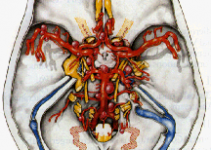For the families of intracerebral hemorrhage victims, the following scenario will sound familiar, almost like a dramatic scene from a TV movie.
It begins at a wedding reception. Grandfather is dancing with the bride, his beloved granddaughter.
Everyone is having such a good time! He is returning to his table to be with Grandmother when he emits a cry and collapses. Loved ones rush to his aid and, for a moment, he seems to be coming out of it.
Then, all notice his speech is not normal; he cannot get up, even though he tries. The right side of his body isn't working at all.
An ambulance rushes him to the hospital.
Everyone is worried. In the emergency room, the CAT scan tells the physicians that he has suffered a serious stroke. A tiny blood vessel has burst and bled under high pressure.
It leaves a path of destroyed brain tissue in its wake and further threatens surrounding brain tissue with more damage, as the mass effect of the large volume of blood compresses the surrounding brain tissue.
The hospital learns of his high blood pressure history.
This is the awful world of the hypertensive stroke.
Table of Contents
EXPLAINING WHAT HAS HAPPENED
The brain is an “end organ.” It is also the most energy-hungry organ in the body. Because of these two factors, it constantly demands a disproportionately large percentage of the blood supply from the heart.
The brain weighs about 5% of the body's total weight, but constantly uses more than 20% of the body's blood supply to survive.
It has both “old parts” and “new parts.” As the human species evolved over the ages, some of the less sophisticated parts of the brain remained unchanged; other parts have been modified as humankind progressed along its evolutionary path.
Among these unchanged brain parts are the very simple, thin-walled blood vessels that supply one of the oldest parts of the brain, the basal ganglia.
This area of the brain is made up of the neurons responsible for the control of coordination and central relay centers for sensation. (Globus pallidus, thalamus, etc. are parts of the brain that are affected by Parkinson's Disease). Of all the vessels in the body, these are the least prepared to handle chronic, increased blood pressure.
At the same time, they are responsible for carrying a larger amount of blood to a very vital area, at relatively high pressures.
Thus, over the years, they can develop microscopic outpouchings called Charcot aneurysms.
These are not at all like cerebral aneurysms that cause subarachnoid hemorrhages (SAH). When the tiny Charcot outpouchings burst, blood enters into the brain at very high pressure, destroying all tissue in its path.
Other Kinds of Intracerebral Hemorrhages
Other hemorrhages include those arising from arteriovenous malformations, unsuspected tumors, brain vessel diseases due to infection, degenerative diseases such as amyloid angiopathy, drug usage (intravenous, amphetamine or cocaine usage), or blood thinner therapies (e.g. coumadin or heparin treatment for heart disease).
Changing Times, Changing Therapies
Until recently, ICH had been treated with watchful waiting, except for those cases in which the size of the hemorrhage demanded surgery.
The brain will eventually absorb the blood over time (three weeks to 2 months).
With the advent of improved surgical techniques, localizing imaging capabilities, and better understanding, a move to early surgical removal or decompression has been the new trend.
Better Understanding
Even if the high-pressure blood hadn't cut a path of brain destruction, the sheer mass of the blood within the brain and the tight confines of the skull can be responsible for continuing damage to surrounding brain tissues.
In this surrounding brain (called the penumbra), the local pressure of a blood clot may be greater than that of its blood supply, causing the brain cells in that area to die off.
To minimize further destruction, therefore, it makes sense to reduce the local pressure by decompressing such brain tissues through the removal of most of the blood clot.
Also, it is now known that blood becomes toxic. Blood cells are tiny packages of chemicals that the body is normally protected from by the cell membranes that contain them.
As the blood cells within a clot die, they swell, burst, and release toxic chemicals that are capable of damaging the surrounding brain. The new approach to this problem is to eradicate such toxins BEFORE they are released.
Improved Imaging Capabilities
No matter how deep and unseen the blood clot, new imaging techniques allow the surgeon to target and see exactly where he needs to go when removing a blood clot.
Stereotactic machinery and real-time intraoperative ultrasound guidance systems have helped tremendously, practically eliminating the downside of surgery.
Improved Surgical Techniques
Smaller openings, better surgical accuracy, improved lighting, the simplicity of needle aspiration techniques, and the usage of surgical hemostatic agents (that prevent post-operative bleeding) all lessen the danger of brain surgery for ICH.
It is now reasonable to remove any and all brain hemorrhages of significant size very soon after the patient has arrived at the hospital.
This new approach has become a part of the “acute care” treatment application to stroke victims. Over the past few years, the medical community has come to consider ICH a near emergency and treated as such.
Your neurosurgeon or neurologist will explain “acute care” treatment early, in the hopes of salvaging undamaged brain when possible.
Delay or Hold on the Surgery
Factors that might delay early removal of an ICH include stabilization of blood pressure or other medical conditions (e.g. diabetes, clotting abnormalities, liver or kidney failure, heart problems, etc.); reversal of medications that prevent blood clotting (e.g. coumadin or aspirin), or Amyloid Disease of the brain.
Most often, surgery is not helpful in these instances, and future blood clots may also occur after a relatively short interval.
Another condition calling for the surgical delay could be the extremely poor neurologic state of the patient.
Even a small hemorrhage in the wrong place (such as the middle of the brainstem) may be associated with such a poor outlook that surgery would not be of help, or it could even result in further damage.




